As the great NBA writer Zach Lowe put it on a recent podcast, “as analytical as sports [now] gets, it’s still about feeling”. The feelings after Notre Dame’s blowout loss in Ann Arbor mirrored the stages of grief – perhaps with an overemphasis on the anger and depression, although there may have been some “what if we sell our soul for Urban Meyer” bargaining thrown in. The analytics offer little solace but instead confirm the grim picture and disturbing trend that’s popped up multiple times in the Brian Kelly era on the road against a similarly talented team.
Something not clear? Check out this handy advanced stats glossary.
Unexpectedly there was the worst kind of garbage time counted in these numbers, beginning when Michigan scored in the 4th quarter to take a 31-7 lead (per SP+, garbage time in the final period begins with a team ahead by 22 or more). This meant 18.3% of plays were thrown out of most statistics below, exceptions including drive statistics and defensive havoc. For what it’s worth, removing garbage time improves how things appear for the Irish, who laid down and gave up 11.4 yards per play on defense in those plays.
Explosiveness
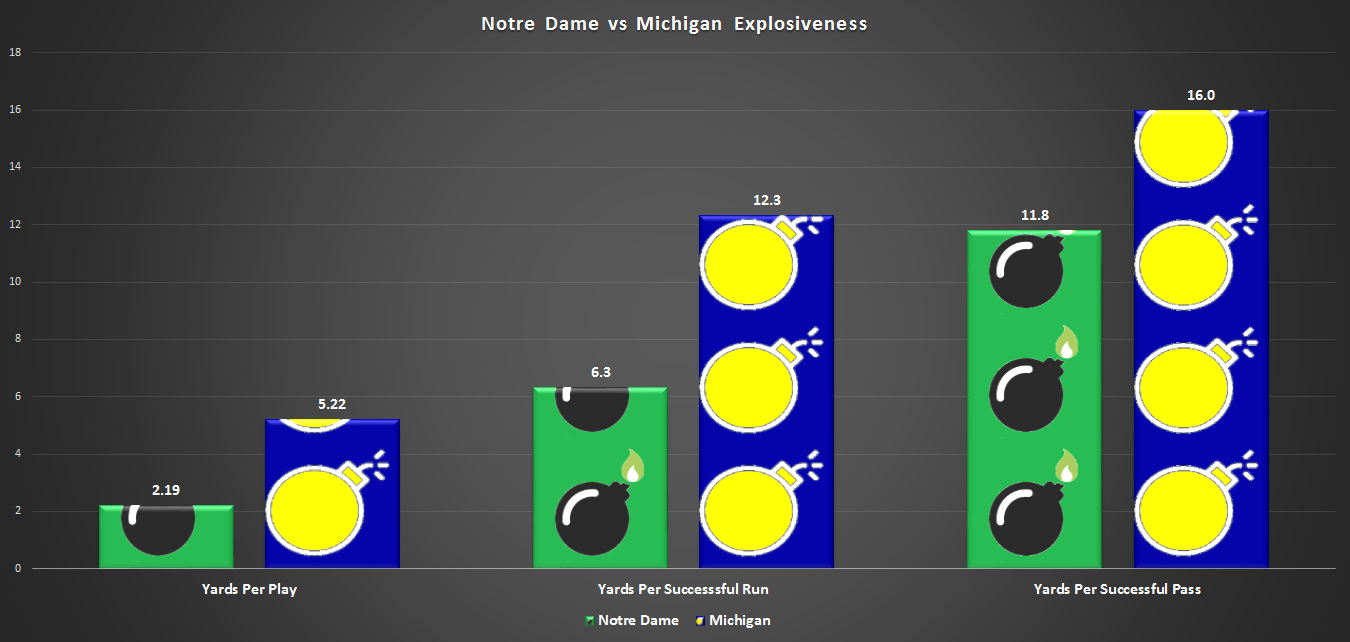
This was not one of those games where one side looks dominant but the statistics suggest it should or easily could have been closer. Even when the Irish closed the gap to ten points in the 3rd quarter they were being out-gained by 3+ yards per play, an early indication they were lucky to still be in the game and ominous signal things would soon get far worse. The final yards per play deficit was not as bad as the Cotton Bowl against Clemson a season ago (-3.8), but was worse than the dreaded Miami no-show in 2017 this evoked many PTSD flashbacks.
If there were any two areas of this Notre Dame team to feel confident in entering the showdown with the Wolverines, it was preventing big plays and stopping the run. Clark Lea’s defense had given up just one run of 20+ yards combined in the games at Georgia and hosting Virginia and USC, and Michigan had struggled to run the ball efficiently against even the Illinois and Army defenses.
That all fell apart in the rain in the Big House, as the Michigan run game was the dominant offensive factor in the game. The Irish defense gave up five runs of 20+ yards, each of which eventually led to a UM score. Even when they weren’t getting gashed on the ground, the Wolverine rushing attack still controlled the game- in a downpour, they ran the ball on 85% of 1st and 2nd down plays, and averaged 7.2 yards per 1st down play. As expected Shea Patterson and the Michigan pass game weren’t great in passing situations, but they avoided them while the game was competitive, with just four passing downs in 32 first half plays. In the first half UM’s average distance to go on 3rd downs was just 3.8 yards, keeping pressure off Patterson that’s often led to him making costly errors this season.
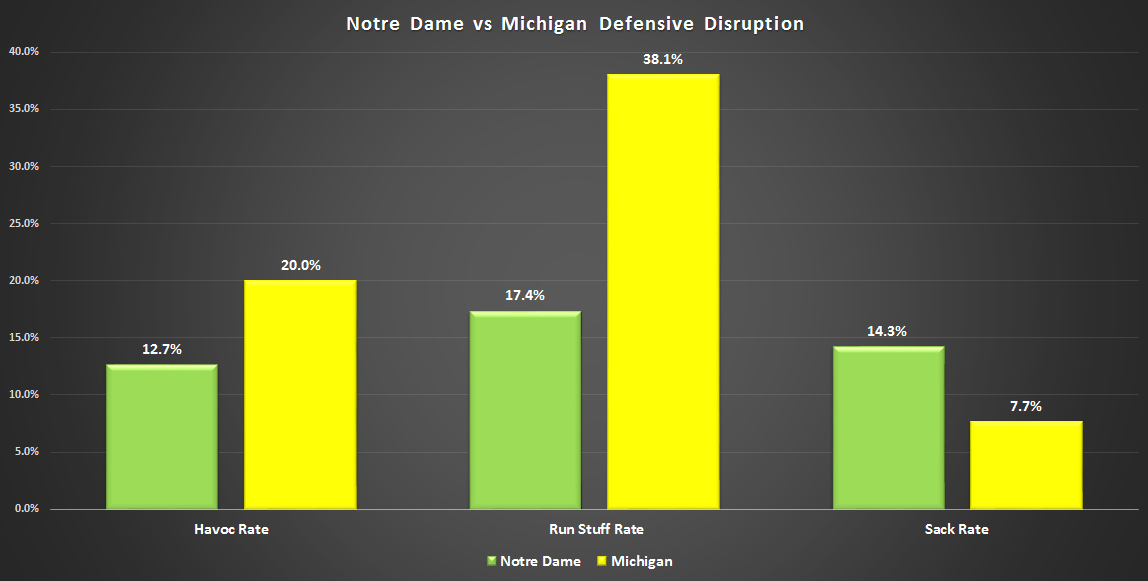
While the defensive effort was more startling since the Wolverines and new coordinator Josh Gattis had been so inept offensively, the offensive effort was even worse. Eight of 21 Irish runs were stopped for no gain or a loss, good for 1.48 yards per carry. Pass attempts were hardly better, hovering between 1.5-2.5 yards per plays for much of the game before settling at 2.77 before garbage time. Nothing worked except for the throw-back touchdown pass to Cole Kmet, and Chip Long versus Don Brown was a bloodbath.
The 2019 season feels like the curtain has slowly been drawn back to unveil more and more of Ian Book’s limitations. There were unnerving signs at Louisville, questions after Georgia but also praise for gutsy effort with a high degree of difficulty, and wins led by the defense (UVA) and run game (USC) that perhaps masked the regression taking place.
Before the season the passing attack felt like one with an extremely high ceiling – even without much improvement Book figured to continue his steady track record of strong efficiency and above-average yards per attempt. Instead, it’s cratered this fall, with issues in vision, comfort in the pocket, and a downturn in accuracy all coming together over the past several games.
Book certainly hasn’t been complemented by the run game – the longest runs in both the Michigan and Georgia losses have been nine yards. Each of those nine-yard gains? Scrambles by Book.
Efficiency
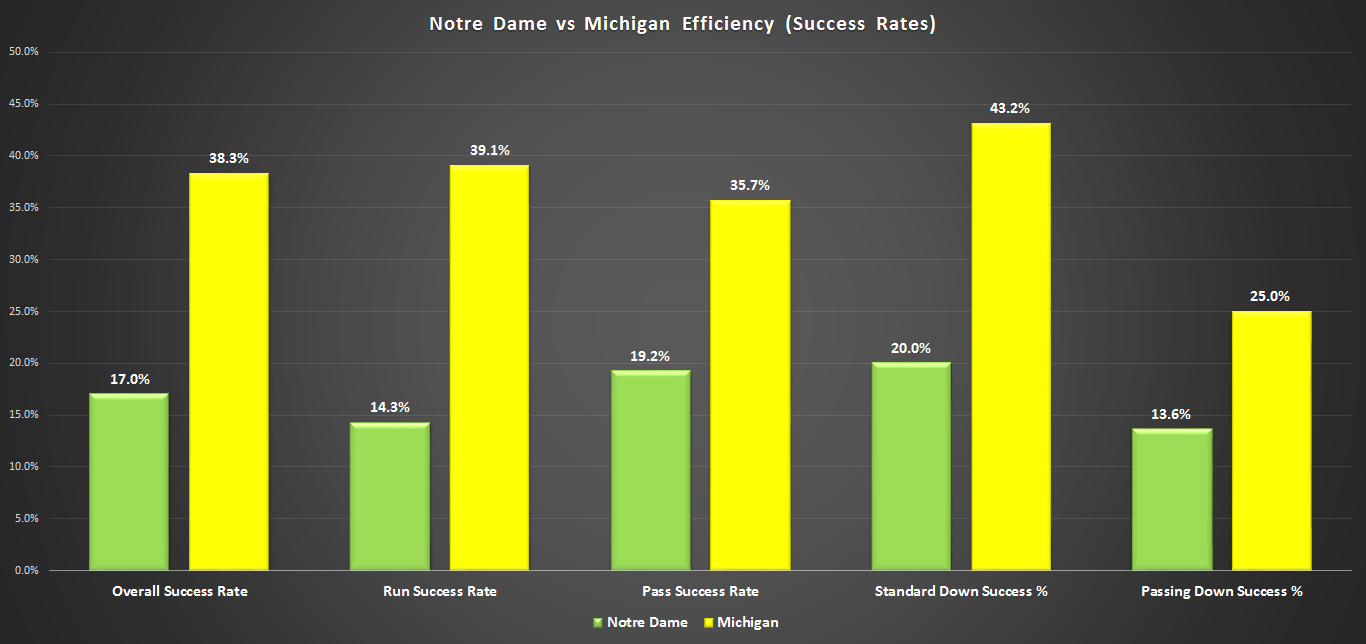
In the consistent driving rain and wind, neither team would be expected to be efficient, but the Wolverines approached national average success rates across the board. Meanwhile, Notre Dame couldn’t muster anything offensively, with a worse success rate than even the Hurricane Matthew game at NC State in 2016 that should have been played on canoes (22.6% success rate).
It’s hard to glean much from the offensive performance because it’s all horrible. Early down success rates were bad, which meant average third downs for Notre Dame were long, which led to poor passing down success and the inability to string drives together. The run and pass efficiency were equally woeful, so it’s hard to be too critical of that ratio, although the scheme and plays themselves proved totally and utterly inadequate.
Defensively there were at least sustained periods of success – after the Wolverines scored to go up 17-0, the Irish defense allowed just 1 yard per play over the next 21 plays, forcing five Michigan punts. Unfortunately the offense could muster only one scoring chance out of it, and finally the dam broke in the 3rd quarter. A 49-yard Hassan Haskins run was the longest play the ND defense has allowed this season and was followed by a couple of defensive pass interference calls that guaranteed a UM touchdown.
Finishing Scoring Drives, Field Position, & Turnovers
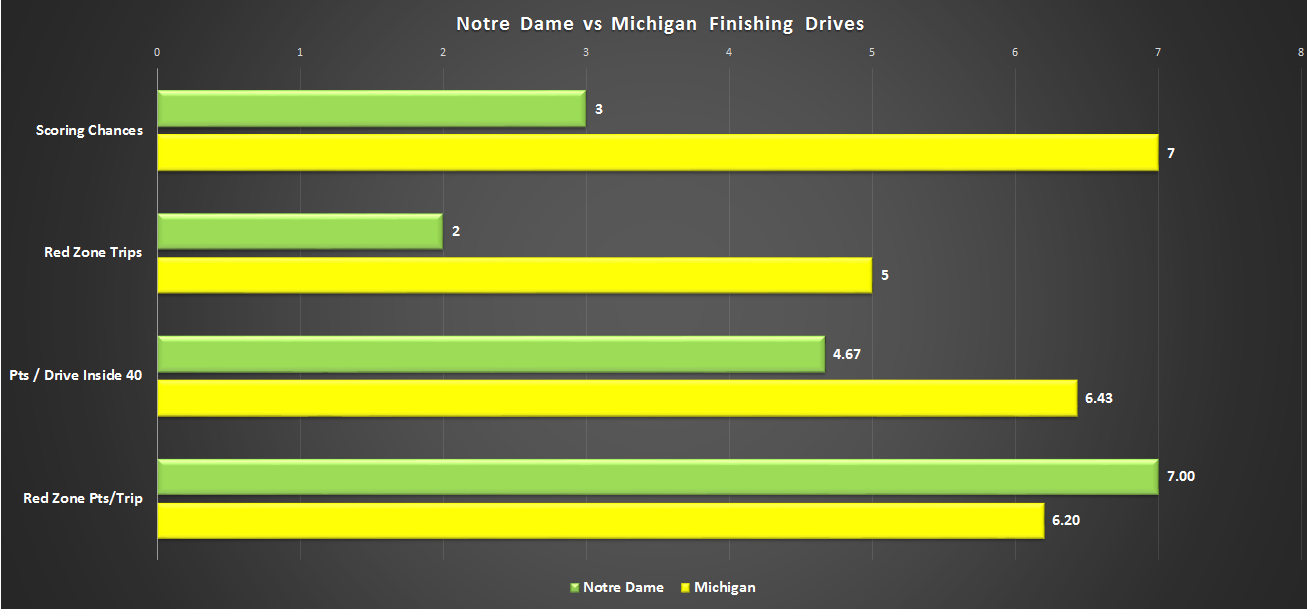
No more good news hiding in here, as Michigan created way more scoring chances and scored more points in each opportunity. I’m no math major, but that guarantees bad things. Notre Dame’s very first drive was gifted a scoring chance after the roughing the punter penalty but was quickly squandered by a snap into a leg and a false start and things snowballed from there.
With Phil Jurkovec’s heroic garbage time effort, the Irish did convert both red-zone visits into touchdowns and is now the last remaining FBS team at a 100% conversion rate for red-zone trips. LSU failed on a 4th and goal from the 2-yard line at Auburn, so the Irish also are tied with Navy for the highest red zone touchdown percentage at 87.5%. Short of winning the rest of the games and making a New Year’s Six bowl (boring), this is now my biggest rooting interest – the red zone national championship can be ours!
The Wolverines claimed an average starting field position edge of three yards, starting at their own 31 versus the Irish at their 28-yard line. Special teams were whatever except early in the game when the errant Jonathan Jones touch of a blocked punt apparently was equivalent to Indiana Jones removing the gold idol in Raiders of the Lost Ark, only in this version our hero is run over by boulders for the next several hours instead of escaping. Jay Bramblett punted ten times, which is too many in my opinion, and some were good and some were bad. I don’t like talking about this game.
There were officially six “fumbles” in this game, and Michigan recovered five which was extremely unhelpful. This includes Jurkovec’s lost one in garbage time, the Jones blocked punt fiasco, and three fumbles that go on Shea Patterson which were all recovered by the Wolverines (the one backward out of bounds was pretty safe in that regard).
Somehow back here again
Unfortunately, we are back in the Bad Place. There was hope we had escaped and were at getting close to someplace else – that the BK program reboot after 2016 was real, with three consecutive 10-win years looking like a given. It would include real playoff contention, an undefeated regular season, and establish the strongest baseline of the Kelly era, which could end on a positive note and leave the program in tremendous shape for his successor.
But no, the Jeremy Bearimy has taken us back to losing on the road unexpectedly, in humiliating fashion, and to a hated rival, the worst of all possible combinations. Last week I wrote about why SP+ rated Notre Dame more poorly than other systems, but that there was real rational upside – if each unit of the team played up to the potential they had flashed at their best, this could be a top-10 team. What I (and most fans) failed to consider was the gloomy inverse – that each inconsistent component could also put forth performances mirroring their worst efforts of the year simultaneously.
This loss casts a shadow on the last years of the Kelly era, however long they may be. It sheds a darker light on 2018, making it harder to believe that 12-0 was more about the quality of that Irish team and less about the softness of that schedule. The story of Brian Kelly in South Bend feels narratively complete for whenever in the next few years it ends. He elevated the program a significant amount versus previous coaches back to Holtz, had several nice runs and made meaningful infrastructure and program investment advancements for whoever follows him. Kelly has been a solid but not great recruiter, which likely played a role but doesn’t explain not being able to break through in big games against top programs with similar or greater talent.
What comes next? Anyone who claims to know is lying. Each level of this team – run defense, pass defense, both parts of the offense – is talented and capable enough to be the best thing on the field in any game. But what can the Irish rely on right now? Nothing on the offense has been consistent week to week, and defensively the Michigan game throws off much of what we thought we knew.

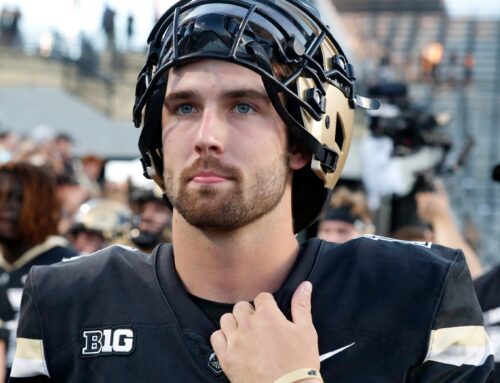
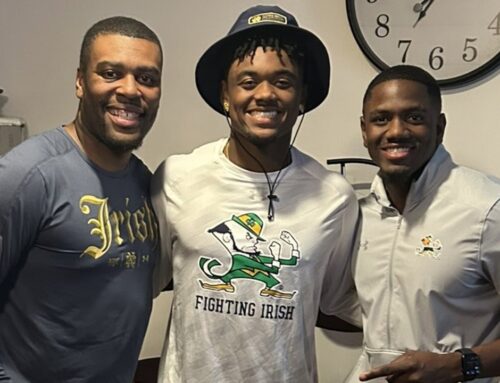

Surely, the advanced stats will make me feel a little better and no.
It seems like Michigan deserves credit for taking advantage of ND’s tendencies / weaknesses. Against ND’s defense, their focus on running was a great counter to ND’s tendency to play back and avoid giving up the big pass play. Against ND’s offense, their pressure and crowding the line took away the run and neutered the short passing game. Now, let’s see if ND can learn from this.
I’ll leave the x’s and o’s stuff to people much smarter than me but I think the UM running ability was less about taking advantage of our desire to prevent long passes and more about our inability to execute. We were bringing LBs and safeties down trying to stop the run, just not disciplined and tackling well which led to the long runs into the spaces we had vacated
From my vantage point in the stadium, it looked like MTA and/or Lacey were getting pushed around almost every play and linebackers were over-pursuing.
Last paragraph is pretty bleak. I guess the hope is that the failure was primarily rain-based and this team will run through the rest of the schedule fine, win a bowl game, and be 11-2. 10-3, 12-1, and 11-2 is still pretty sell-able recruiting-wise, I’d think.
Not to rain on my upvote party parade, but: I don’t think this is going to happen! I’m just being hopeful.
My kingdom for a competent offensive coaching staff.
Didn’t need advanced stats to see what happened. They stuffed our run game while running all over us, plus it was pouring rain, negating passing from either team.
I didn’t think PJ was particularly “ heroic” in the 4th quarter. He looked kinda slow and awkward to me, although in fairness the field soaking wet. I don’t think he’s the QB messiah we’re hoping for.
My kingdom for a stable of blue chip offensive skill players: qb, rb and receivers, the hallmark of an elite football program.
RIP advanced stats, killed by Guy Who Saw What Happened.
You noticed! It’s amazing how many people don’t believe what they see
Yes that is the lesson of the last couple decades in sports analytics – the eye test tells us all we need to know and all conventional wisdom is true, don’t look into it at all because it will just tell you what you know
Quite a take from the guy who last week came here to talk about how Book’s performance being down was irrelevant!
Maybe you missed it that neither qb could pass, but Michigan ran all over us and we couldn’t run at all. But it was the qb’s fault?
I’ve been watching football longer than you’ve been alive, Michael. And I come from a tier 1 football family. Somehow we could all get by without a bunch of statisticians to tell us why one team won and the other lost in a game like that.
And if I recall, you posted the comments of The Godfather of advanced stats who was gobsmacked at how ND could have beaten USC contrary to what his beloved stats told him.
So, no, I’ll trust my own eyes and experience.
You don’t come from a tier 1 family of internet commentators.
So I guess one has to just agree with you guys no matter what.
I’ve never been a sheep, Eric.
Nah, we’ve had a decade of people disagreeing with each other.
You’re just wildly swinging at the air about advanced stats and not really putting any coherent argument together. Did you even disagree with anything or just kind of say it’s dumb I know what I see?
Neither your family nor years of watching football mean anything to me. There’s a whole lot of older folks with bad football takes all over the internet, and you’ve failed to bring any good evidence to any discussion to support your idea analytics and advanced stats aren’t valuable. Instead you use straw man arguments that presuppose that I or others are advocating for using stats in place of what we’ve seen, instead of both complementing and revealing where maybe we are biased if what we are observing and recalling, which is often the case. If you want to engage constructively I am happy to continue to conversation but I’m not going to beat my head against a wall to convince you of something about you reflexively argue against without good reason and seemingly without good faith.
Why must you convince me? It’s not a religion, this advanced stats thing.
Can you please diagram that 3rd sentence?